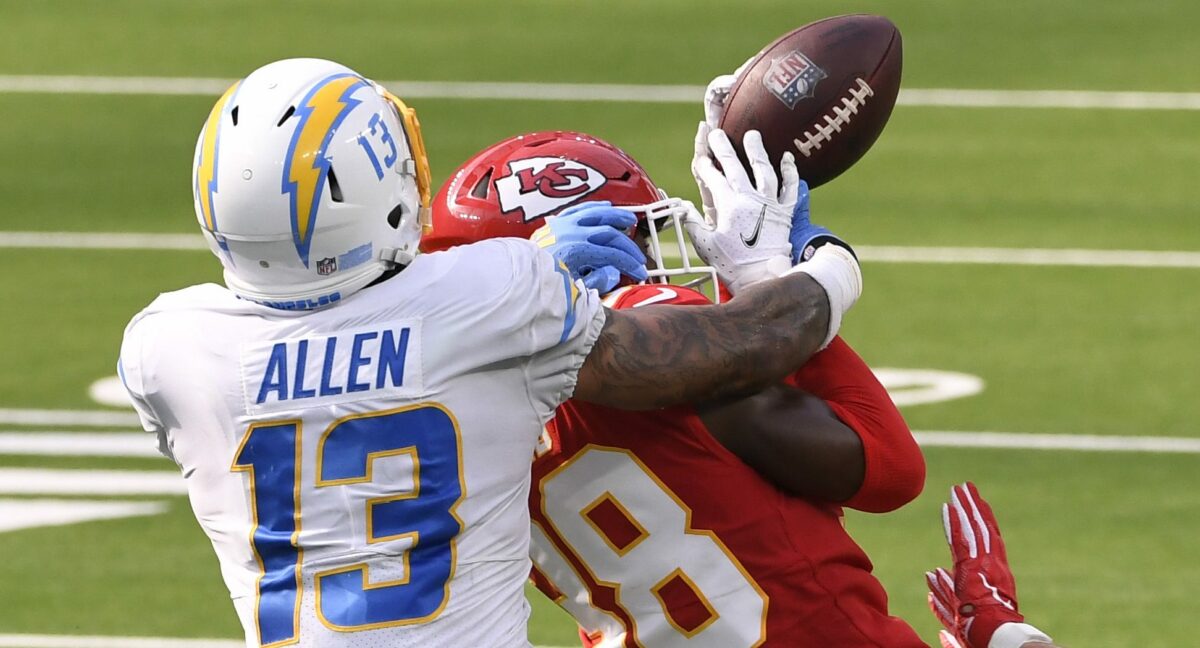In the 2022 NFL season, per Sports Info Solutions, there were 4,801 dropbacks in which quarterbacks eventually threw a pass with a zero-step drop, or a one-step drop. Basically, the quickest quick game throws possible. On those dropbacks, quarterbacks completed 3,212 of 4,591 passes (70%) for 23,231 yards (6.15 YPA), 149 touchdowns, 55 interceptions, and a passer rating of 87.3. Last season, six NFL teams – the Buccaneers, Dolphins, Bills, Broncos, 49ers, and Seahawks – had more than 200 dropbacks with those quick-throw snaps, so it’s a staple for a lot of teams.
The point here is that with so much quick game in today’s NFL, you’re not always going to be able to get to the quarterback before he releases the ball, no matter how great your pass rush is. It’s one reason that interior pressure has become so important, but it’s also why you’d better be able to disrupt receivers with press coverage. Not that any team plays off all the time, but if you play off too much, opposing offenses are likely to look at that, smile, and say, “Hey, thanks – we’ll take the easy gains all day long.”
The origins of aggressive press coverage, where you’re not just mirror-matching receivers through the route, but you’re actively jamming them off their routes, go back a long way. You can start with the Kansas City Chiefs and Oakland Raiders in the American Football League, transition it through the 1970’s Pittsburgh Steelers, and go from there. One of the most prominent examples of aggressive coverage came in Super Bowl XXXVI, when the underdog New England Patriots upset the St. Louis Rams, 20-17. In that game, Patriots head coach Bill Belichick had a gutsy strategy to defeat Mike Martz’s “Greatest Show on Turf” offense — he was going to beat up the Rams’ receivers, and he was going to specifically target running back Marshall Faulk by taking his edge defenders and going after the epicenter of St. Louis’ offense with all kinds of nastiness.
What became known as the “Bull’s-eye” game plan worked magnificently.
In “The Games that Changed the Game,” the book he co-authored with Ron Jaworski and David Plaut, Greg Cosell of NFL Films and ESPN’s NFL Matchup got specifically into the details of that game plan, and why it worked. We discussed it in detail on this week’s “Xs and Os with Greg Cosell,” and then spun it forward to how teams are using “Bull’s-eyes” in today’s NFL to limit all kinds of explosive plays.
[mm-video type=video id=01h2wta1vhtwy9gfs0xr playlist_id=none player_id=none image=https://images2.minutemediacdn.com/image/upload/video/thumbnail/mmplus/01h2wta1vhtwy9gfs0xr/01h2wta1vhtwy9gfs0xr-d4692c2d37f42dc155138c1ff2a983c6.jpg]
One play from last season typified this approach. In their 30-27 Week 11 win over the Los Angeles Chargers, the Kansas City Chiefs were dealing with a situation in which Justin Herbert had the ball at the Kansas City three-yard line with 23 seconds left in the first half. The Chargers were already up, 17-13, and a touchdown here would have created more problems. Defensive coordinator Steve Spagnuolo’s response was to go full Bull’s-eye, to great effect.
Herbert started his read to the front side of his 2×2 formation, made a 3×2 set with running back Austin Ekeler aligned to the right. At the snap, defensive end George Karlaftis bombed through to the backfield, and altered Ekeler’s angle route. This caused Herbert to pause, and it also gave the Chiefs time to pressure him, which might not have happened otherwise. Flushed out to his left, Herbert then tried to hit receiver Keenan Allen to the back side on a switch release, but cornerback L’Jarius Sneed had Allen on lock in press coverage, and the result was a deflection.
That play may have saved the game for the Chiefs.
[mm-video type=video id=01h2wv6azvh9ezvxtf3j playlist_id=none player_id=none image=https://images2.minutemediacdn.com/image/upload/video/thumbnail/mmplus/01h2wv6azvh9ezvxtf3j/01h2wv6azvh9ezvxtf3j-d85a3e070735132731af8d9b1c997ab9.jpg]
“There were a lot of things going on on that play,” Greg said. “First of all, you’re in the low red zone, and in the low red zone, you’re usually not asking your quarterback to take deep drops and scan the field. So, Herbert was reading to his right, which was the three-receiver side, because Ekeler was set to the right in the backfield. They ran kind of a smash concept with the wide receiver [DeAndre Carter] and the tight end [Stone Smartt]. The tight end was kind of open; we don’t know why Herbert didn’t throw it if that was indeed his read. But they had Ekeler on a ‘Texas’ or angle route, and Karlaftis ‘Bull’s-eyed’ him.
“[Herbert’s] not really coming back to the other side in s strict sense because you’re in the low red zone, but the Chiefs did a really good job in a press-man look with the slot and the outside receiver in switching, because it was a switch release off the line of scrimmage by the two receivers.”
Whether it’s quick game or downfield stuff, the ability of defenses to alter route concepts with aggressive physicality can make all the difference. It was true in the 1960s, it was true in Super Bowl XXXVI, and it’s true today.
You can listen and subscribe to the Xs and Os” podcast on Spotify…
…and on Apple Podcasts.
